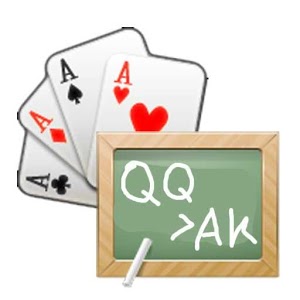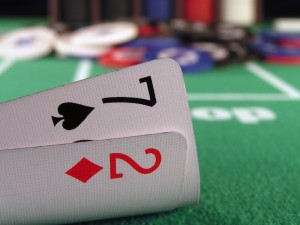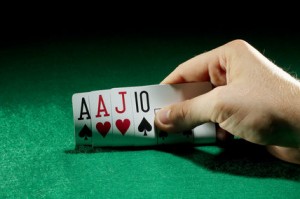Big-blind-versus-small-blind play, small ball, floating, and the bluff-raise
What follows is a special preview from Jeff’s book, Advanced Pot-Limit Omaha Volume II: LAG Play.
It’s a 50¢-$1 pot-limit Omaha (PLO) game online, five-handed. You ($125.15) are dealt the K 10
10












1. You should:
a. Fold
b. Call
c. Raise
Action: You call.
Flop ($6): 9












2. Your opponent bets $4. You should:
a. Fold
b. Call
c. Raise
Action: You call.
Turn ($14): 2




3. Your opponent bets $14. You should:
a. Fold
b. Call
c. Raise
Grades and Analysis
1. a(0), b(10), c(4). You are guaranteed to be heads up with the positional advantage; as such, folding is not really an option with a hand with any sort of potential. Calling and playing small ball is the standard play. Three-betting here is OK, but my preference is to keep the pot small and the stacks deep, in order to maintain full use of the positional advantage.
2. a(8), b(10), c(0). You could fold; after all, a gutshot is all that you have at this point. That said, this is a classic floating situation. You have the nut gutshot-straight draw with some overcards and backdoor draws, and the positional advantage, heads up, against a weak continuation-bet. The play is to peel one off and see what your opponent does on the turn.
Raising here is a mistake, as you don’t want to get reraised off your draw.
3. a(8), b(0-2), c(10). This is a tough decision to grade, as none of the answers are necessarily wrong, except for maybe (b), calling, depending on how you look at it. Again, you could fold and chalk it up to a mistimed float, or whatever. However, that would be missing the big picture.
To bet again on the turn, your opponent’s range is basically 9-9-X-X or 5-5-X-X for the overfull, or, more likely, air. Rather than having a flopped top or even middle set, it is far more likely that he has air — or maybe something like 9-8-7-6 — and is just following through with a standard second barrel to end the hand. Moreover, a lot of players who flop top or middle set tend to check the turn when the board pairs, to give their opponents a chance to either bluff or hit a draw to a second-best hand, but that is far from a given.
A slim possibility exists that your opponent has something like A-A-X-X for aces up, and is just trying to avoid giving a free card to a straight or flush draw, but in that case, there is little need for him to bet the full pot on the turn.
The play here is to bluff-raise, to try to pick up the pot.
Calling and extending the float would be creative (hence the 0-2 point range), but not optimal in this case. I would give more credit to calling (floating) if you had a hand like the A















And, obviously, if you do call, you would do so with the intention of betting the river unimproved, assuming that your opponent checks the river. Otherwise, if you choose to call for the sake of calling on its own merits, you get a zero.
In the actual hand, I raised to $38 and my opponent folded
Submit your review | |








